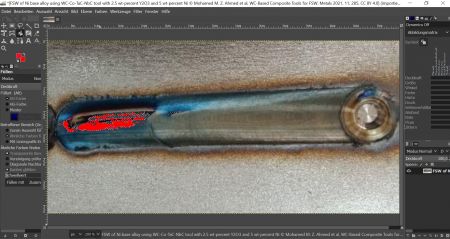Surface morphology: Difference between revisions
m (Stephan Kallee at AluStir moved page Surface Morphology to Surface morphology) |
No edit summary |
||
| Line 7: | Line 7: | ||
<div style="clear:both;"> | <div style="clear:both;"> | ||
Friction stir welding (FSW) of Ni base alloy and of carbon steel was conducted during the development of WC-based composite tools for FSW of high-softening-temperature materials at the Prince Sattam Bin Abdulaziz University in Saudi Arabia and the Suez University in Egypt et al.<ref name="Ahmed">Mohamed M. Z. Ahmed, Waheed S. Barakat, Abdelkarim Y. A. Mohamed 3, Naser A. Alsaleh and Omayma A. Elkady: ''The Development of WC-Based Composite Tools for Friction Stir Welding of High-Softening Temperature Materials.'' Metals 2021, 11, 285, [https://doi.org/10.3390/met11020285 https://doi.org/10.3390/met11020285], [https://creativecommons.org/licenses/by/4.0/ CC BY 4.0.]</ref> | Friction stir welding (FSW) of Ni base alloy and of carbon steel was conducted during the development of WC-based composite tools for FSW of high-softening-temperature materials at the Prince Sattam Bin Abdulaziz University in Saudi Arabia and the Suez University in Egypt et al.<ref name="Ahmed">Mohamed M. Z. Ahmed, Waheed S. Barakat, Abdelkarim Y. A. Mohamed 3, Naser A. Alsaleh and Omayma A. Elkady: [https://www.mdpi.com/2075-4701/11/2/285/pdf ''The Development of WC-Based Composite Tools for Friction Stir Welding of High-Softening Temperature Materials.''] Metals 2021, 11, 285, [https://doi.org/10.3390/met11020285 https://doi.org/10.3390/met11020285], [https://creativecommons.org/licenses/by/4.0/ CC BY 4.0.]</ref> | ||
[[File:FSW tool parts after consolidation, grinding for the required geometries and insertion in the tool steel holder © Mohamed M. Z. Ahmed et al, WC-Based Composite Tools for FSW. Metals 2021, 11, 285, CC BY 4.0.jpg|thumb|left|upright=1.5|FSW tool parts after consolidation, grinding for the required geometries and insertion in the tool holder<ref name="Ahmed"/>]] | [[File:FSW tool parts after consolidation, grinding for the required geometries and insertion in the tool steel holder © Mohamed M. Z. Ahmed et al, WC-Based Composite Tools for FSW. Metals 2021, 11, 285, CC BY 4.0.jpg|thumb|left|upright=1.5|FSW tool parts after consolidation, grinding for the required geometries and insertion in the tool holder<ref name="Ahmed"/>]] | ||
Revision as of 16:04, 6 December 2021
Surface morphology is a subset of analytical imaging to describe the macroscopic and microscopic appearance of the top surface friction stir welds
In some cases, high spatial resolution imaging made with sophisticated microscopes is used to produce images of products, samples and objects that cannot be seen with the naked eye.
Friction stir welding of steel

Friction stir welding (FSW) of Ni base alloy and of carbon steel was conducted during the development of WC-based composite tools for FSW of high-softening-temperature materials at the Prince Sattam Bin Abdulaziz University in Saudi Arabia and the Suez University in Egypt et al.[1]
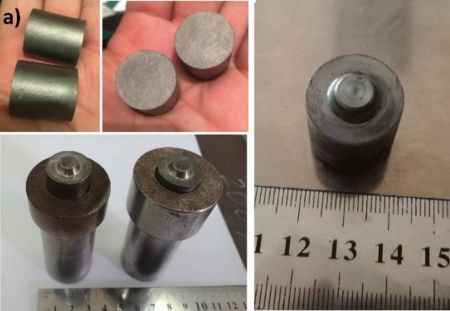
The FSW tool was made from WC-based composites with 5 wt% Ni and 2.5 wt% Y2O3.[1]
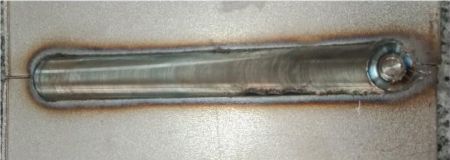
A visually acceptable weld shows a homogeneous surface from the start to the stop. The annealing colors above the heat affected zone are superficial colorations that result from the application of heat. They can be used on some materials such as stainless steels and copper alloys to assess and monitor the heat input during and even after FSW.
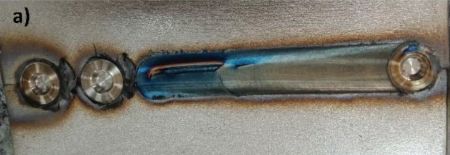
If large surface breaking voids, as at the start of this weld, or small surface breaking voids are visible, as at near the middle of this weld, the weld does not meet the acceptance criteria described in ISO 25239-1:2020(en) — Part 5: Quality and inspection requirements, which is, strictly speaking, only applicable to aluminium.[2]
Image processing with Fuzzy Select Tool (Magic Wand) in GIMP 2.10. GIMP (GNU Image Manipulation Program) is a pixel-based graphics program that includes functions for image editing and digital painting of raster graphics. The programme is free software and can be used free of charge.
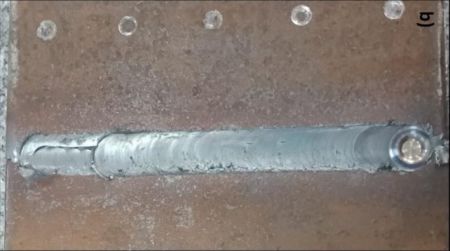
When welding carbon steel the annealing colors are less visible as shown here on a weld that shows some surface anomalities at the start.
References
- ↑ 1.0 1.1 1.2 1.3 1.4 1.5 1.6 Mohamed M. Z. Ahmed, Waheed S. Barakat, Abdelkarim Y. A. Mohamed 3, Naser A. Alsaleh and Omayma A. Elkady: The Development of WC-Based Composite Tools for Friction Stir Welding of High-Softening Temperature Materials. Metals 2021, 11, 285, https://doi.org/10.3390/met11020285, CC BY 4.0.
- ↑ ISO 25239-5:2020(en) Friction stir welding — Aluminium — Part 5: Quality and inspection requirements.
